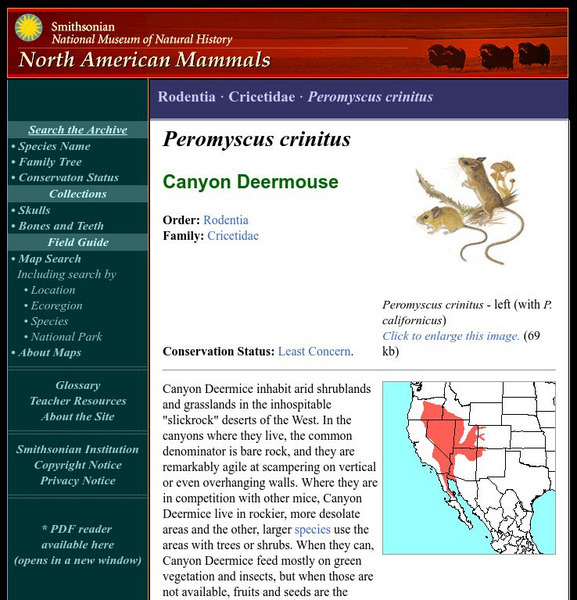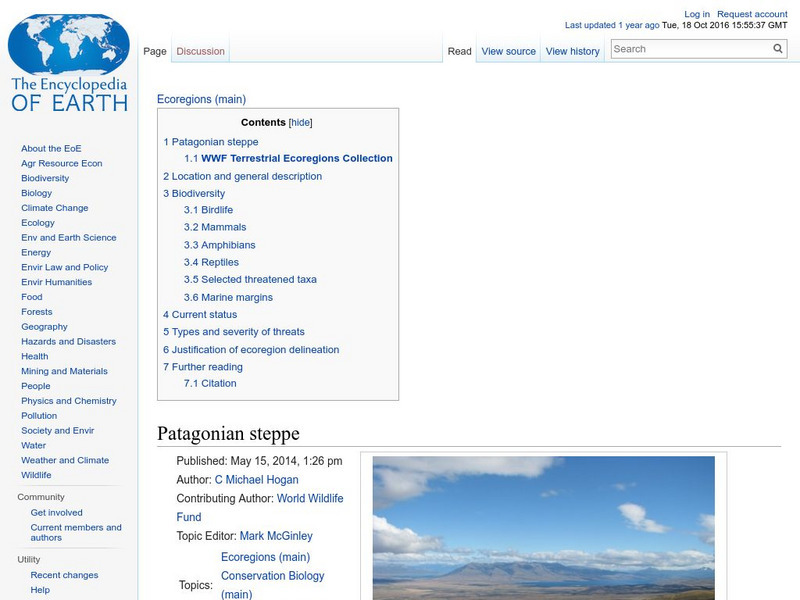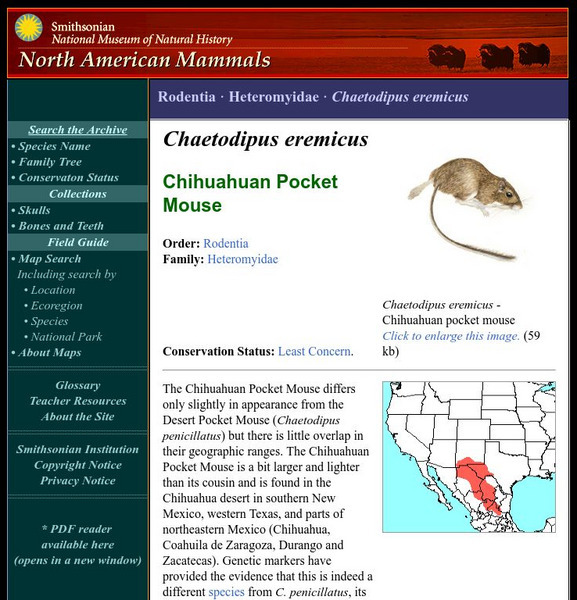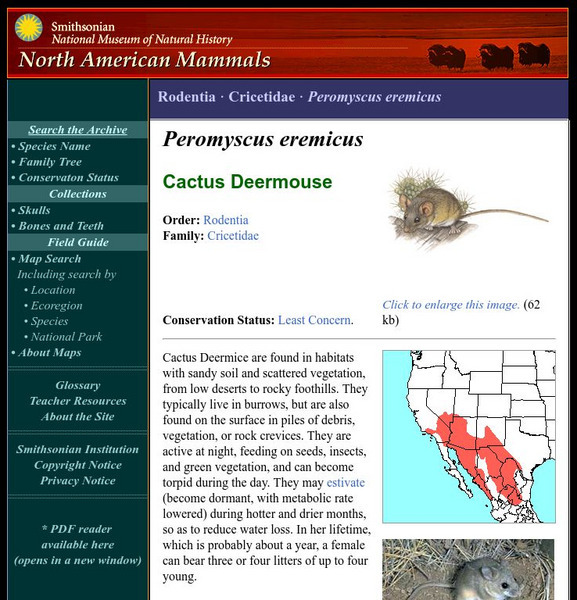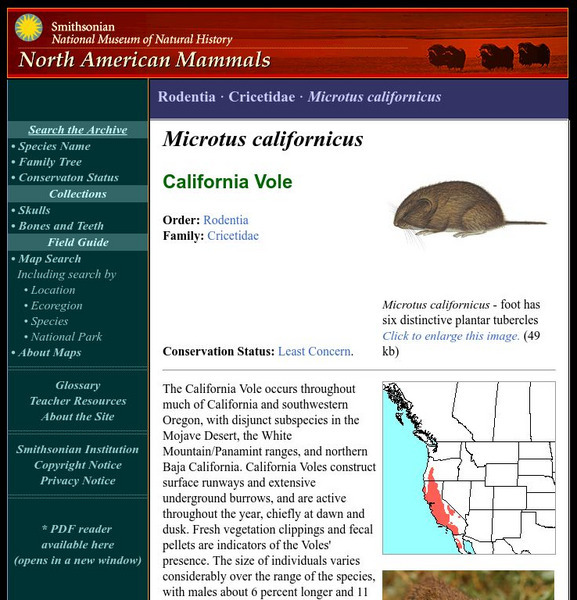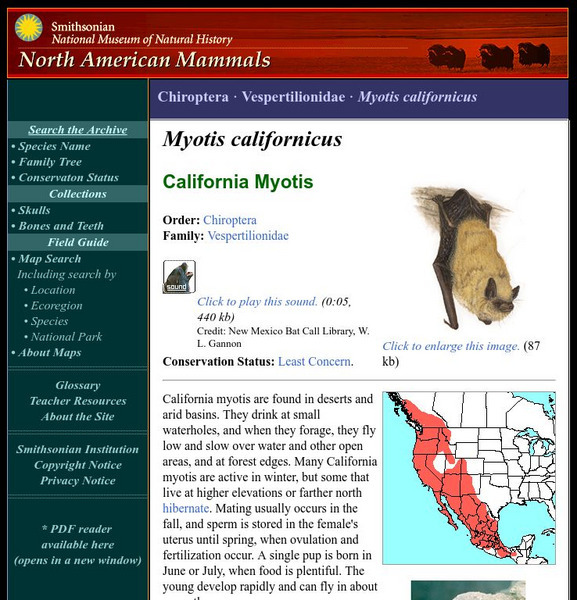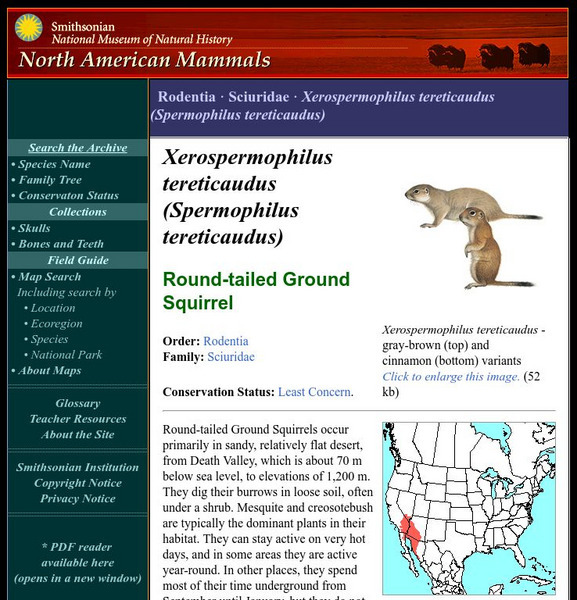American Forum for Global Education
American Forum for Global Education: Challenge of the Desert
This elementary exploration of interdependence from the American Forum for Global Education touches on language arts, social studies, and science. Students understand the connection between themselves and their natural environment.
Other
Desert Usa: Harvester Ants
This article about harvester ants examines their behavior, but it also looks at the role these ants play in mythology, especially in Native American stories, and at the social structure of ant colonies. There is also a link to a related...
PBS
Pbs Teachers: Scientific American: About All You Can Eat: Feast or Famine
Investigate the theory that including desert plants such as mesquite and cactus in a diet can help control obesity and diabetes. Design a scientific experiment that will test this hypothesis, using control variables, observation and...
Smithsonian Institution
National Museum of Natural History: American Mammals: Canyon Deermouse
Canyon Deermice inhabit arid shrublands and grasslands in the inhospitable "slickrock" deserts of the West. In the canyons where they live, the common denominator is bare rock, and they are remarkably agile at scampering on vertical or...
Palomar Community College District
Major Biomes of North America
A good review of basic terminology followed by descriptions and pictures of the North American biomes.
Encyclopedia of Earth
Encyclopedia of Earth: Patagonian Steppe
In this resource, students can investigate the location, biodiversity, and threats to the Patagonian steppe ecoregion and also find helpful links to further explore information about this area.
Library of Congress
Loc: Frank Lloyd Wright Designs for an American Landscape
A site covering Frank Lloyd Wright from 1922-1932. Specific information on how his architecture was designed with the environment in mind. The Exhibition was at the Library of Congress from 1966 until 1997.
PBS
Pbs American Experience: Erwin Rommel (1891 1944)
This site is a brief biography of the military career of Erwin Rommel, the German Field Marshall during WWII.
American Museum of Natural History
American Museum of Natural History: O Logy: Face to Fossil: Protoceratops
Questions and answers about Protoceratops andrewsi, presented as an "interview" with a museum's fossil. Learn about the dinosaur, the age of the fossil, and how the museum had it transported.
Library of Congress
Loc: Frank Lloyd Wright
Rich with drawings, photographs, and text, this site from the Library of Congress is an online exhibit of Frank Lloyd Wright's ideas for a new American landscape and the place of architecture in it.
The History Cat
The History Cat: Us History: Louisiana Purchase
Covers two topics related to the growth of the new United States - the Louisiana Purchase and the settling of the Great Plains. How the Louisiana Purchase came about as a result of a decision by Napoleon is explained. The Great Plains...
ClassFlow
Class Flow: Southwest Literacy Unit
[Free Registration/Login Required] This flipchart is a literacy unit based around a Southwest / Westward Expansion Theme. Native Americans, pioneers, and the old west is covered. 8 different literacy strategies are taught with FULL...
Curated OER
Etc: Maps Etc: North American Vegetation Regions, 1901
A map from 1901 of North America, Central America, Greenland, and the Caribbean to Puerto Rico showing the general vegetation regions. The map shows areas of deserts, tundras, and ice fields, areas of grassy lands, areas of open forests,...
Smithsonian Institution
National Museum of Natural History: American Mammals: Chihuahuan Pocket Mouse
The Chihuahuan Pocket Mouse differs only slightly in appearance from the Desert Pocket Mouse (Chaetodipus penicillatus) but there is little overlap in their geographic ranges. The Chihuahuan Pocket Mouse is a bit larger and lighter than...
Smithsonian Institution
National Museum of Natural History: American Mammals: Southwestern Myotis
Southwestern myotis live in a variety of southwestern mountain habitats, from desert grasslands up into pine and mixed coniferous forest in the United States, and in desert and grassland in Mexico. These bats and two other myotis...
Smithsonian Institution
National Museum of Natural History: American Mammals: Long Tailed Pocket Mouse
The range of the Long-tailed Pocket Mouse is mostly within the Mojave Desert, Colorado Desert, and the Great Basin. On cold nights, this animal becomes inactive and usually remains within its burrow system during winter. Learn more about...
Smithsonian Institution
National Museum of Natural History: American Mammals: Least Chipmunk
The least chipmunk is the smallest and most widely distributed North American chipmunk. It occurs in a variety of habitats, from coniferous forests to meadows to sagebrush desert, feeding primarily on seeds but also eating flowers, buds,...
Smithsonian Institution
National Museum of Natural History: American Mammals: Cactus Deermouse
Cactus Deermice are found in habitats with sandy soil and scattered vegetation, from low deserts to rocky foothills. They typically live in burrows but are also found on the surface in piles of debris, vegetation, or rock crevices. Learn...
Smithsonian Institution
National Museum of Natural History: American Mammals: Bobcat
The Bobcat is the most widely distributed native cat in North America. Bobcats occupy many habitat types, from desert to swamp to mountains. Learn more about the Lynx rufus, more commonly known as a Bobcat, in this easy-to-read species...
Smithsonian Institution
National Museum of Natural History: American Mammals: California Vole
The California Vole occurs throughout much of California and southwestern Oregon, with disjunct subspecies in the Mojave Desert, the White Mountain/Panamint ranges, and northern Baja California. California Voles construct surface runways...
Smithsonian Institution
National Museum of Natural History: American Mammals: California Myotis
California myotis are found in deserts and arid basins. They drink at small waterholes, and when they forage, they fly low and slow over water and other open areas, and at forest edges. Learn more about the Myotis californicus, more...
Smithsonian Institution
National Museum of Natural History: American Mammals: Round Tailed Ground Squirrel
Round-tailed Ground Squirrels occur primarily in sandy, relatively flat desert, from Death Valley, which is about 70 m below sea level, to elevations of 1,200 m. They dig their burrows in loose soil, often under a shrub. Learn more about...
Smithsonian Institution
National Museum of Natural History: American Mammals: Chisel Toothed Kangaroo Rat
The Chisel-toothed Kangaroo Rat has chisel-shaped lower incisors, with which it strips the epidermis from the leaves of desert shadscale or saltbush, thereby reaching the palatable and water-rich interior of the leaf. This Kangaroo Rat...
Smithsonian Institution
National Museum of Natural History: American Mammals: Mexican Long Nosed Bat
The Mexican long-nosed bat feeds mainly on the nectar and pollen of agaves, and is found in Texas in June and July when the plants are in bloom there. Then it migrates southward into Mexico, where it lives in pine-oak forests and...





